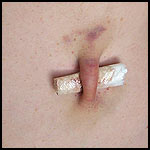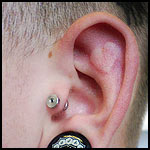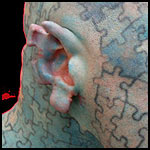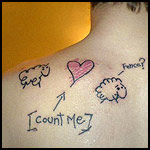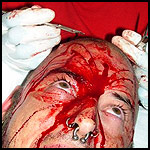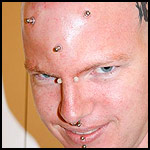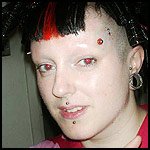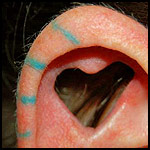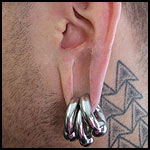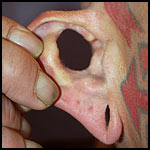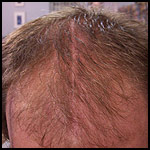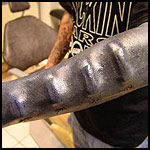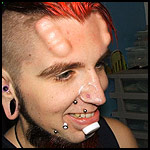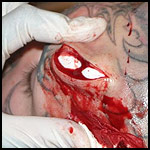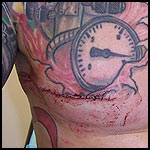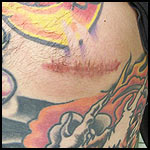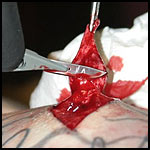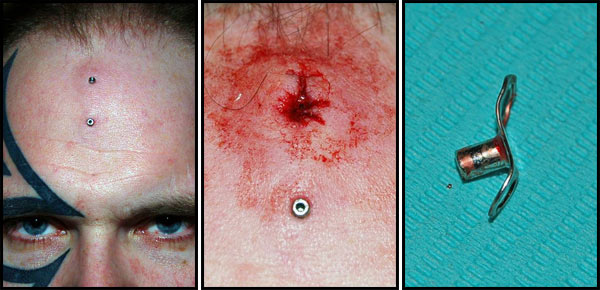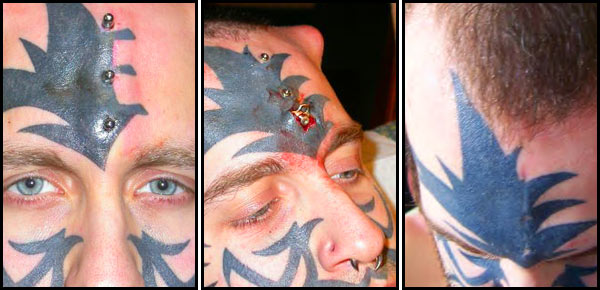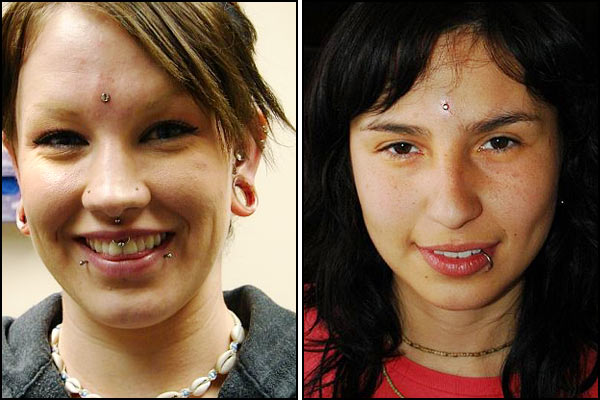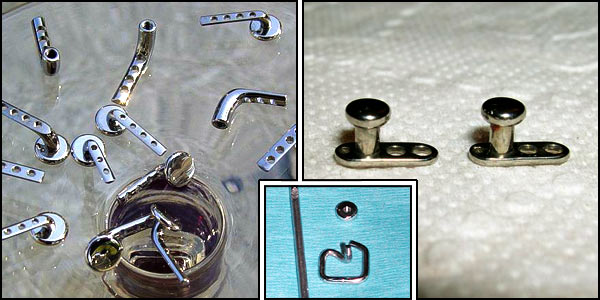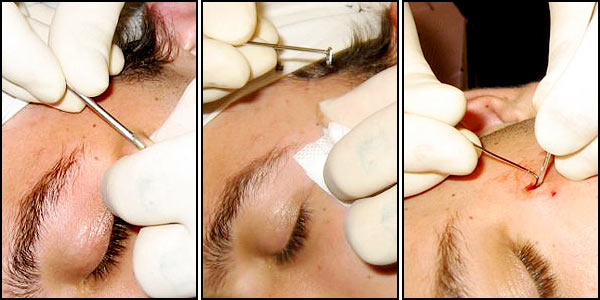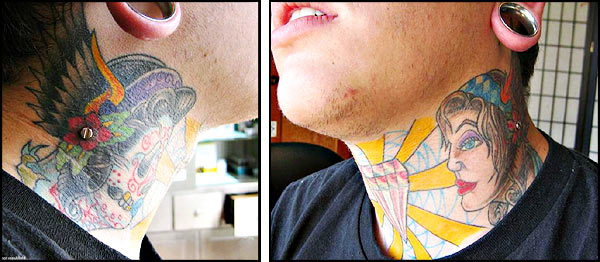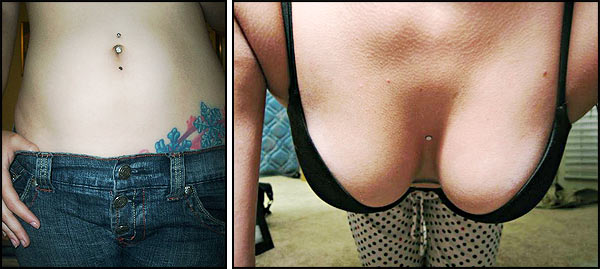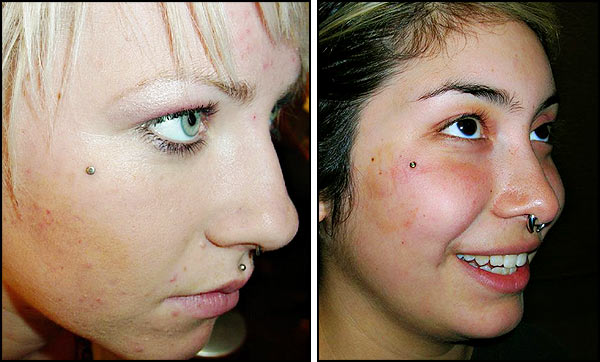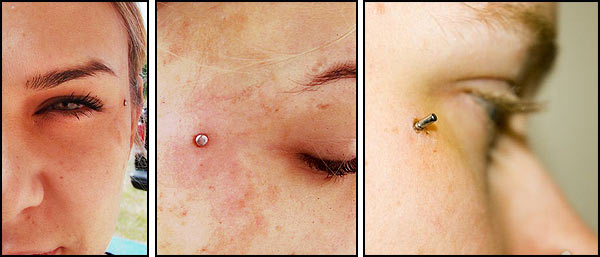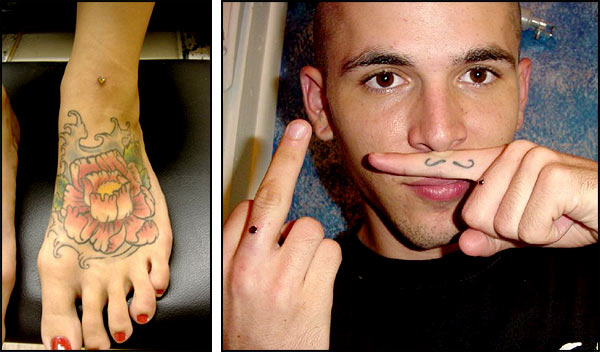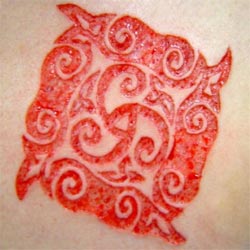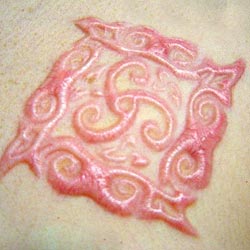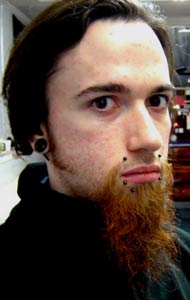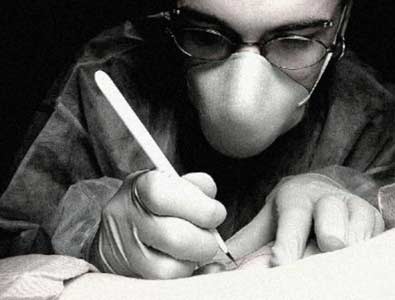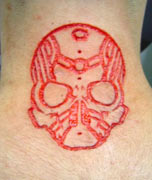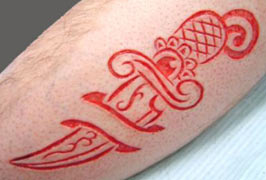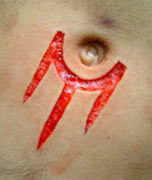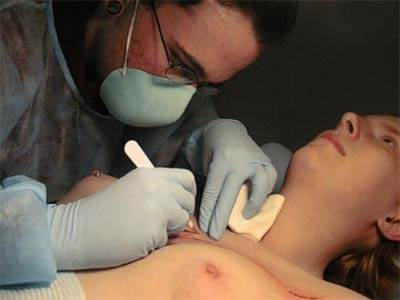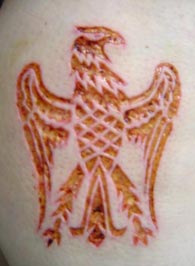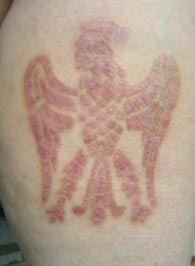|
|
||
|
Howie (iam:Howie, LunaCobra.net) is one of a handful of controversial cutting edge body modification practitioners both pushing the limits of and defining this subculture’s procedural options as he travels around the word reshaping people with pseudo-surgical sculpture in the name of Art… and Love. * * * How did you first get interested in body modification? I always loved tattoos as a young child, but as far as non-tattoo mods, maybe it started when I went to an all boys boarding school in the snow belt of the USA. We had to wear a tie every day, our hair had to be cut in a certain way, and no ear rings or anything like that were allowed — that is when I started to put holes in my body and did a few cuttings. A lot of the other guys wanted cuttings so I began doing scars in the dorms on the down low… It was not easy as we were always under watch and could not have blades or anything, so I used to make my own cutting tools. It was so jail-style — I think I liked that about it back then — to make art and say a big fuck you to the oppressors. What name do you like for what you do — “cutter”, “body modification artist”, “practitioner”, or something else? How about “SUPERARTMAN”… yes, that would be best. But seriously then — it’s primarily about “art”? Yes, sir, it is. I think when I first met you (in 2000?) you were just getting started as an artist… How did you learn your skills, and how have you honed them? I lived with a family member while he was finishing med school and became friends with a few of his classmates. Before I started to do heavy mods I used to show them photos of things and talk about it with them, and they started to teach me. We used to stitch meat in our kitchen all the time — during many of my first procedures one of them would be in the room with me helping. I would video tape lots of my work and go over it with them or even call them right in the middle of what I was doing to ask advice. And let’s be honest here — what we as body modification artists do is surgery. Surgery in a way, yes… but at the same time the motivations and so on are quite different so I can see why people find the term difficult, especially since surgery comes with so many connotations and legal hangups. TRUE… I’m still honing my skills all the time, and I have changed how I do some mods even in the past two years — take nipple removals for example. At first I would make normal sutures, but every guy has a different chest — some have tighter skin and some are overweight which can put a lot of pressure on the wound — so now I use a long lasting heavy internal suture for that procedure. I never stop trying to make my artwork better, and continue to review my work with surgeons and learn as much as I can. For those that don’t know what internal sutures are, do you mind describing them? There are many different kinds of sutures and they are used in all kinds of ways for different parts of the body. Internal stitches provide a longer hold and are always done only on the inside of the body. What have you found the general attitude of people in the medical profession is toward heavy mods, and to those who perform those modifications? Would they like to do those procedures, or are they happy to see this gray market that they exist in? The fact that people not in the medical profession do this sort of work worries most doctors. As far as if they would want to do these kinds of mods, they don’t think much of it — most if not all would not do it because its not worth much money. Why would they set up a clean room for $200 to $800? It’s just not worth it to them. If that weren’t an issue, would the world be a better place if the medical industry embraced the legality and legitimacy of atypical procedures? Hell, I think it would be great if it any of that happened — amazing things could be done if they would — but I’m about 99.9% sure it will never happen. With a family that includes doctors, do you think there’s a similar internal drive in both you and them, just expressed in different ways, that took you to your respective careers? Yes. Anyone that has seen me and and them together knows we are almost the same people. We look a bit different but are very close and very alike. What is the range of procedures you do? I do all kinds of implants — even some that people have not seen yet *wink* — most anything cut-and-stitch, dermal punches, scalpel piercing, and tongue splits. I do a lot of reconstruction like ear lobes, and removals of things like transdermals and put the skin back to normal. I do a lot of cartilage removal, elf ears — pointing — and lots more! How does extreme modification — moving into “the unhuman” — change a person, versus tattooing or piercing which tends to be make more of a “decorated human”? I see heavy mods in a lot of cases as looking more like decoration. Sometimes it can be more, and I love it when it goes farther… It’s like I’m living in a fantasy land. Your tattoo style seems reminiscent of some of the modern tattoo styles I see coming out of France, but without being “French” if that makes sense… What are you trying to express? I understand what your saying, but I don’t think it’s like the work out of France… as the work I see like mine from those guys is just so clean… It looks like it has laws. I see my work as letting go — freedom, heart, and mind, smashing together to make something more than art. Just PURE LOVE — that is why I put a heart in most every tattoo I do. Which are your favorite kinds of body modifications to do? I’m not sure. It’s all rather the same to me, but my favorite is when I work on someone that is happy both before and after the work. I do almost anything above the belt, but I only do a few things (like transscrotals) below the belt. The only thing that I can say I dislike about mods is that some people make a connection to sex — I never liked that and try to stay away from mods that could relate to that. I find that a interesting comment, because I think I’m probably one of the people who sees it as being strongly linked to sex, both in obvious ways (genital mods), and in the larger sense that I believe that most modification is motivated by “mating dance” type behavior (like how male animals seeking out a mate will go out of their way to be very flamboyant or do outrageous dances and so on). I think that the shift from heavy mods out of the sexual arena is definitely something new though, and something that artists such as yourself have been very influential in causing. I can see and agree with the “mating dance” idea — but any other link to sex is something I don’t want to have anything to do with or even know about. What do you think motivates people to get modifications? I cant speak for others, so I will just answer for myself: ART and LOVE. You are often seen as the “he’ll do anything” guy in terms of pushing the limits of procedures… And I think when people say that, they don’t mean it in an entirely flattering way. How would you respond to accusations that you are not “cautious” enough or don’t have the right “limits”? Honestly, unless they are a surgeon they don’t know what they are talking about. Who are they to say what the limit is? They just like to talk on the Internet because they like to bitch and be part of gossip. Of course I have limits and there are lots of things I turn down. Like what? I get asked for some odd things — many are below the belt and I don’t even want to mention them. I was asked to remove an eyeball, and I would never even think of doing something like that. I’ve heard people say that artists should play it “safe” and not do procedures that are too “shocking” or high risk because it attracts undue attention from legislators — that is, your actions could cause laws to be put in place that restrict others. Do you think there’s truth to that, or that it’s dishonest and makes concessions that shouldn’t be made? I don’t think anyone should tell a person what they can or can not do to themselves… that’s fucking crazy. Go hard if that is what you want to do. In relation to the law, every country is different but it’s already illegal to do a lot of this in many parts of the USA… There’s not much we can do about that. It’s never going to be truly legal, so whatever. I guess the official stance is that part of being a government and a doctor is “protecting people from themselves” which is, for example, why anti-drug laws exist, and why a cosmetic surgeon is often legally and ethically obliged to deny the person an atypical procedure. Well hey, I’m not going to tell an adult what they can and can not do. If they ask me to do something and they understand what they are getting into, and I can see the ART of it, then I will work with them. There are a number of firsts that I’d credit you with as a practitioner — the eyeball tattooing, the antitragus removal, and I’m sure others… Oh, there have been more, *wink, wink* How does the process of coming up with new procedures work and what does it feel like? Sometimes I’ll be talking with doctors in my family, or another surgeon about something they did or learned that was new, and it gives me an idea, or starts a spark that ends up as this new modification idea. I might look at a face, or be watching a movie, and see something and apply that visual in my work… but any time I do something new I talk to a surgeon about it. When I’m doing something new I would not say it’s fun, because I want to see it heal before I can jump for joy and be prideful about it. Then it’s fun, but when I’m in doing something for the first time it’s just scary. For example, when I removed that big strip of transdermals from Jake’s head that you posted photos of, after I made the peel and did some elevation, pulling it together and knowing I only had forty minutes until we had to drive him to the airport so he could fly home… With the time pressure and a much bigger wound then I have ever had to stitch shut and it was on his head — that was a lot of scary! When I got to see his head again in Las Vegas a few months ago, I was proud and excited to see how well it worked out. People went crazy on me for doing that but it worked very well — he now is even growing hair through most of his scar tissue! As someone that’s worked all over the world, what are some of your favorite places to work? I have been to many places all over the world and lived in many of them as well, and from that I can tell you — IT IS ALL THE SAME! Sure, you may have some different food or weather, but all in all, people are people, and it’s all planet Earth. That being said, I love all islands, and for sure the Pacific islands. Does traveling internationally complicate your work? Yes, at first it was a big pain in the ass, but after a while I had tools in most areas of the world I was working or was able to make them in tool shops I knew of in the other areas. It helps that I know a lot of people that have been very kind with me — I could not have done the travel and work I did without them. Sometimes I knew a bit of the country’s language, but other times I needed someone who could translate and help with aftercare. Is a lot of what you do through a strong word-of-mouth network? How do most people find out about you? Yes, for sure. In the past few years it’s all word-of-mouth — over 50% of the people I work on are not even on the web in any way, or have not been on any bodymod sites before. Do you think the extreme mainstreaming of heavy modification is a good thing or a bad thing? I don’t think about to be honest… it will be what it will be. With anesthetics being sort of “gray area” in many regions both in terms of applying them and acquiring them, what is your attitude on anesthetic use? Yes, that is a spicy tomato! Bottom line is that if you do this work and you don’t use anesthetics, you’re doing it half ass. Without something to slow the flow of blood, you can not see the tissue layers properly, so if you want to do it right you use it — I use it at all times. Ideally, what laws and regulations — if any — would you like to see governing artists such as yourself, both for the protection of the clients and practitioner? In my view Johnny Law has no place in my ART. We should talk a little about complications — you’ve had a few procedures go wrong, most notably a pair of very pointy horn implants that rejected, and a set of nipple removals where the client was unhappy with the scarring. The pointy implants were on Jim, a friend of mine. I wish I’d only done two — going for five was not a good idea… But I think you’re asking why we did it at all, seeing as they were so pointy? He had been wearing regular domes in his head for some time and didn’t like how they looked and loved the idea of having horns that were pointy — and I agreed. I think it looks amazing to have something pointy in that area. I had the silicone pointy horns and we talked it over for a day or two when I traveled to see him. I think we both loved the idea of how the pointy horns would look so much that we got carried away with it all and went for putting five of them in. In hindsight, if I had only put in two it would have been a great story. So… we went with five, and after a week or two it went very bad. Two of the five broke the skin — three worked, but since it would have been off-balance to have two on one side and one on the other, three were removed. We pushed the limits of what kind of shape can be done, and that I feel was a success as he still wears two of them. Putting in too many at once was a very bad idea that I wish I could take back. I also wish I could have stayed around longer to monitor it — it’s very hard to travel and do this sort of work. Ideally I would have stayed for at least ten days, but I only stayed for around three days. This all went down a bit over two years ago I think, and I’ve kept in touch with him since. Jim still loves how the two worked out and doesn’t want to take them out. On the nipple removal, yes, I also blame myself for not taking into account that he had a heavy chest — this puts a lot of pressure on it. Back then I didn’t do internal stitches, but because of that I’ve switched to using both internal and two kinds of external stitches, even with skinny people. I think maybe people have unrealistic expectations about what nipple removal will do — it’s rare to be left without a scar or to completely eliminate nipple response since it’s not a mastectomy. Yes, one will always have a scar when this is done. I told this client it would scar, but I did not expect his to scar as badly as it did, and his scarred much more than the previous four pairs I’d done. I think the main thing about nipple removal is the size of the person — if you carry a lot of weight and have a large chest, or your skin is tight, your scar will be much bigger than a skinny person. His chest was the largest I had worked on, and this was before I started to use internal stitches on them — I wish I would have used them on him. I know if I had we would both be more happy with his scar. On another nipple removal I did where the person was unhappy with the scar, I later removed the scar in a second procedure and I used two kinds of external stitches and also internal stitches to repair it and they now have a much smaller mark. I suppose we’re both getting criticized for the eyeball tattooing — I believe a recent quote from a prominent member of this community was “idiotic and disturbing”…? We all knew what we were getting into that day so they can’t say shit — fuck em! Why do folks gotta be dicks and talk trash stuff they don’t know anything about? I’m going to start a solid black eye tomorrow! I do think that people do like to call you out for some reason, whereas it seems like there are other practitioners who can do no wrong… YES!!! Because I’ve been traveling internationally for a many years, it’s a numbers game — the more work you do, the more people you meet in other countries, the more people that might not like you… or even hate you. Not only that, but I’m loud, outspoken, and a shit-stirrer, so it all adds up the current mess… but at least it’s only online and not in person. Do you mind talking about what procedures tend to cost, like ear pointing and implants for example? How do you determine pricing? The price does change — ear pointing can be anywhere from $200 to $700 US. It all depends on that person’s body and what country I am in at the time, and how much it costs me to be there — and even how I think it will look on them. I often do work for little to no money if that person is short on funds and I think it will look nice on them. If someone wants work from you, how do they do that, and how do you determine your touring schedule? They can go to my website — www.lunacobra.net — and contact me through there or just email me [email protected]. Often I just wait till I have a few people in a country till I come over. Now I’d like to have someone in each country that wants to learn to do what I do so I can make each trip about spreading knowledge — it almost seems like a waste to not do it that way at this point in the mod world. Thanks for talking to us Howie, and good luck on future adventures and art! |
Profile: “MAN-JAW” “I began my surgical facial modifications over a year ago now. It started when I approached Howie on IAM to try some anti-eyebrow domes after being refused by a variety of different international artists.” “Howie agreed to do the experimental work after a few phone discussions, and we caught up on one of his tours in Australia. From there we have throughly planned out and executed the entire project from start to finish. Now, with over ten facial implants and various other surgical mods I can finally see my conception taking shape.” “We are living in a new age of mods where we can explore past limitations and into an entirely new level of expression.” MINI-PORTFOLIO
Forehead implant removal procedure.
As well as on BME, Howie’s work has been regularly featured on ModBlog. |
|

Shannon Larratt
BME.com



